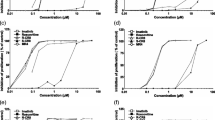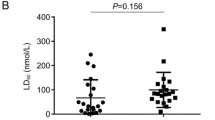Summary
Acute myeloid leukemia (AML) is the most common form of acute leukemia with dismal long-term prognosis with age. The most aggressive subtype of AML is MLL-AML that is characterized by translocations of the mixed-lineage leukemia gene (MLL) and resistance to conventional chemotherapy. Cyclin dependent kinase 9 (CDK9) plays a crucial role in the MLL-driven oncogenic transcription, and hence, inhibiting activity of CDK9 has been proposed as a promising strategy for treatment of AML. We investigated the therapeutic potential of CDKI-73, one of the most potent CDK9 inhibitors, against a panel of AML cell lines and samples derived from 97 patients. CDKI-73 induced cancer cells undergoing apoptosis through transcriptional downregulation of anti-apoptotic proteins Bcl-2, Mcl-1 and XIAP by majorly targeting CDK9. Contrastively, it was relatively low toxic to the bone marrow cells of healthy donors. In MV4–11 xenograft mouse models, oral administration of CDKI-73 resulted in a marked inhibition of tumor growth (p < 0.0001) and prolongation of animal life span (P < 0.001) without causing body weight loss and other overt toxicities. The study suggests that CDKI-73 can be developed as a highly efficacious and orally deliverable therapeutic agent for treatment of AML.





Similar content being viewed by others
Explore related subjects
Discover the latest articles and news from researchers in related subjects, suggested using machine learning.References
Thein MS, Ershler WB, Jemal A, Yates JW, Baer MR (2013) Outcome of older patients with acute myeloid leukemia: an analysis of SEER data over three decades. Cancer 119(15):2720–2727. https://doi.org/10.1002/cncr.28129
Derolf ÅR, Kristinsson SY, Andersson TM-L, Landgren O, Dickman PW, Björkholm M (2009) Improved patient survival for acute myeloid leukemia: a population-based study of 9729 patients diagnosed in Sweden between 1973 and 2005. Blood 113(16):3666–3672. https://doi.org/10.1182/blood-2008-09-179341
Krivtsov AV, Figueroa ME, Sinha AU, Stubbs MC, Feng Z, Valk PJ, Delwel R, Dohner K, Bullinger L, Kung AL, Melnick AM, Armstrong SA (2013) Cell of origin determines clinically relevant subtypes of MLL-rearranged AML. Leukemia 27(4):852–860. https://doi.org/10.1038/leu.2012.363
Liu W, Deng L, Song Y, Redell M (2014) DOT1L inhibition sensitizes MLL-rearranged AML to chemotherapy. PLoS ONE 9(5):e98270. https://doi.org/10.1371/journal.pone.0098270
Godfrey L, Kerry J, Thorne R, Repapi E, Davies JOJ, Tapia M, Ballabio E, Hughes JR, Geng H, Konopleva M, Milne TA (2017) MLL-AF4 binds directly to a BCL-2 specific enhancer and modulates H3K27 acetylation. Exp Hematol 47:64–75. https://doi.org/10.1016/j.exphem.2016.11.003
Horton SJ, Jaques J, Woolthuis C, van Dijk J, Mesuraca M, Huls G, Morrone G, Vellenga E, Schuringa JJ (2013) MLL-AF9-mediated immortalization of human hematopoietic cells along different lineages changes during ontogeny. Leukemia 27(5):1116–1126. https://doi.org/10.1038/leu.2012.343
Liedtke M, Cleary ML (2009) Therapeutic targeting of MLL. Blood 113(24):6061–6068. https://doi.org/10.1182/blood-2008-12-197061
Mueller D, Bach C, Zeisig D, Garcia-Cuellar MP, Monroe S, Sreekumar A, Zhou R, Nesvizhskii A, Chinnaiyan A, Hess JL, Slany RK (2007) A role for the MLL fusion partner ENL in transcriptional elongation and chromatin modification. Blood 110(13):4445–4454. https://doi.org/10.1182/blood-2007-05-090514
Martino V, Tonelli R, Montemurro L, Franzoni M, Marino F, Fazzina R, Pession A (2006) Down-regulation of MLL-AF9, MLL and MYC expression is not obligatory for monocyte-macrophage maturation in AML-M5 cell lines carrying t(9;11)(p22;q23). Oncol Rep 15(1):207–211. https://doi.org/10.3892/or.15.1.207
Yokoyama A, Lin M, Naresh A, Kitabayashi I, Cleary ML (2010) A higher-order complex containing AF4 and ENL family proteins with P-TEFb facilitates oncogenic and physiologic MLL-dependent transcription. Cancer Cell 17(2):198–212. https://doi.org/10.1016/j.ccr.2009.12.040
Baker A, Gregory GP, Verbrugge I, Kats L, Hilton JJ, Vidacs E, Lee EM, Lock RB, Zuber J, Shortt J, Johnstone RW (2016) The CDK9 inhibitor Dinaciclib exerts potent apoptotic and antitumor effects in preclinical models of MLL-rearranged acute myeloid leukemia. Cancer Res 76(5):1158–1169. https://doi.org/10.1158/0008-5472.CAN-15-1070
Garcia-Cuellar MP, Fuller E, Mathner E, Breitinger C, Hetzner K, Zeitlmann L, Borkhardt A, Slany RK (2014) Efficacy of cyclin-dependent-kinase 9 inhibitors in a murine model of mixed-lineage leukemia. Leukemia 28(7):1427–1435. https://doi.org/10.1038/leu.2014.40
Johnson AJ, Yeh Y-Y, Smith LL, Wagner AJ, Hessler J, Gupta S, Flynn J, Jones J, Zhang X, Bannerji R, Grever MR, Byrd JC (2012) The novel cyclin-dependent kinase inhibitor Dinaciclib (SCH727965) promotes apoptosis and abrogates microenvironmental cytokine protection in chronic lymphocytic leukemia cells. Leukemia 26(12):2554–2557. https://doi.org/10.1038/leu.2012.144
Kumar SK, LaPlant B, Chng WJ, Zonder J, Callander N, Fonseca R, Fruth B, Roy V, Erlichman C, Stewart AK (2015) Dinaciclib, a novel CDK inhibitor, demonstrates encouraging single-agent activity in patients with relapsed multiple myeloma. Blood 125(3):443–448. https://doi.org/10.1182/blood-2014-05-573741
Liu X, Shi S, Lam F, Pepper C, Fischer PM, Wang S (2012) CDKI-71, a novel CDK9 inhibitor, is preferentially cytotoxic to cancer cells compared to flavopiridol. Int J Cancer 130(5):1216–1226. https://doi.org/10.1002/ijc.26127
Shao H, Shi S, Huang S, Hole AJ, Abbas AY, Baumli S, Liu X, Lam F, Foley DW, Fischer PM, Noble M, Endicott JA, Pepper C, Wang S (2013) Substituted 4-(thiazol-5-yl)-2-(phenylamino)pyrimidines are highly active CDK9 inhibitors: synthesis, X-ray crystal structures, structure-activity relationship, and anticancer activities. J Med Chem 56:640–659. https://doi.org/10.1021/jm301475f
Walsby E, Pratt G, Shao H, Abbas AY, Fischer PM, Bradshaw TD, Brennan P, Fegan C, Wang S, Pepper C (2014) A novel Cdk9 inhibitor preferentially targets tumor cells and synergizes with fludarabine. Oncotarget 5(2):375–385. https://doi.org/10.18632/oncotarget.1568
Lam F, Abbas AY, Shao H, Teo T, Adams J, Li P, Bradshaw TD, Fischer PM, Walsby E, Pepper C, Chen Y, Ding J, Wang S (2014) Targeting RNA transcription and translation in ovarian cancer cells with pharmacological inhibitor CDKI-73. Oncotarget 5(17):7691–7704. https://doi.org/10.18632/oncotarget.2296
Placke T, Faber K, Nonami A, Putwain SL, Salih HR, Heidel FH, Kramer A, Root DE, Barbie DA, Krivtsov AV, Armstrong SA, Hahn WC, Huntly BJ, Sykes SM, Milsom MD, Scholl C, Frohling S (2014) Requirement for CDK6 in MLL-rearranged acute myeloid leukemia. Blood 124(1):13–23. https://doi.org/10.1182/blood-2014-02-558114
Diab S, Teo T, Kumarasiri M, Li P, Yu M, Lam F, Basnet SK, Sykes MJ, Albrecht H, Milne R, Wang S (2014) Discovery of 5-(2-(phenylamino)pyrimidin-4-yl)thiazol-2(3H)-one derivatives as potent Mnk2 inhibitors: synthesis, SAR analysis and biological evaluation. ChemMedChem 9(5):962–972. https://doi.org/10.1002/cmdc.201300552
Wu Y, Yao X, Zhu M, Qian H, Jiang L, Lan T, Wu M, Pang J, Chen Y (2016) PKG II reverses HGF-triggered cellular activities by phosphorylating serine 985 of c-Met in gastric cancer cells. Oncotarget 7(23):34190–34200. https://doi.org/10.18632/oncotarget.9074
Tadesse S, Yu M, Mekonnen LB, Lam F, Islam S, Tomusange K, Rahaman MH, Noll B, Basnet SK, Teo T, Albrecht H, Milne R, Wang S (2017) Highly potent, selective, and orally bioavailable 4-Thiazol-N-(pyridin-2-yl)pyrimidin-2-amine cyclin-dependent kinases 4 and 6 inhibitors as anticancer drug candidates: design, synthesis, and evaluation. J Med Chem 60(5):1892–1915. https://doi.org/10.1021/acs.jmedchem.6b01670
Bansal H, Bansal S, Rao M, Foley KP, Sang J, Proia DA, Blackman RK, Ying W, Barsoum J, Baer MR, Kelly K, Swords R, Tomlinson GE, Battiwalla M, Giles FJ, Lee KP, Padmanabhan S (2010) Heat shock protein 90 regulates the expression of Wilms tumor 1 protein in myeloid leukemias. Blood 116(22):4591–4599. https://doi.org/10.1182/blood-2009-10-247239
Natoni A, Murillo LS, Kliszczak AE, Catherwood MA, Montagnoli A, Samali A, O'Dwyer M, Santocanale C (2011) Mechanisms of action of a dual Cdc7/Cdk9 kinase inhibitor against quiescent and proliferating CLL cells. Mol Cancer Ther 10(9):1624–1634. https://doi.org/10.1158/1535-7163.mct-10-1119
Garriga J, Xie H, Obradovic Z, Grana X (2010) Selective control of gene expression by CDK9 in human cells. J Cell Physiol 222(1):200–208. https://doi.org/10.1002/jcp.21938
Garriga J, Graña X (2014) CDK9 inhibition strategy defines distinct sets of target genes. BMC Res Notes 7:301–301. https://doi.org/10.1186/1756-0500-7-301
Wang S, Fischer PM (2008) Cyclin-dependent kinase 9: a key transcriptional regulator and potential drug target in oncology, virology and cardiology. Trends Pharmacol Sci 29(6):302–313. https://doi.org/10.1016/j.tips.2008.03.003
Morales F, Giordano A (2016) Overview of CDK9 as a target in cancer research. Cell Cycle 15(4):519–527. https://doi.org/10.1080/15384101.2016.1138186
Rahaman MH, Kumarasiri M, Mekonnen LB, Yu M, Diab S, Albrecht H, Milne RW, Wang S (2016) Targeting CDK9: a promising therapeutic opportunity in prostate cancer. Endocr Relat Cancer 23(12):T211–T226. https://doi.org/10.1530/erc-16-0299
Choudhary GS, Al-harbi S, Mazumder S, Hill BT, Smith MR, Bodo J, Hsi ED, Almasan A (2015) MCL-1 and BCL-xL-dependent resistance to the BCL-2 inhibitor ABT-199 can be overcome by preventing PI3K/AKT/mTOR activation in lymphoid malignancies. Cell Death Dis 6:e1593. https://doi.org/10.1038/cddis.2014.525
Pan R, Ruvolo VR, Wei J, Konopleva M, Reed JC, Pellecchia M, Andreeff M, Ruvolo PP (2015) Inhibition of Mcl-1 with the pan–Bcl-2 family inhibitor (−)BI97D6 overcomes ABT-737 resistance in acute myeloid leukemia. Blood 126(3):363–372. https://doi.org/10.1182/blood-2014-10-604975
Bose P, Grant S (2013) Mcl-1 as a therapeutic target in acute myelogenous leukemia (AML). Leuk Res Rep 2(1):12–14. https://doi.org/10.1016/j.lrr.2012.11.006
Glaser SP, Lee EF, Trounson E, Bouillet P, Wei A, Fairlie WD, Izon DJ, Zuber J, Rappaport AR, Herold MJ, Alexander WS, Lowe SW, Robb L, Strasser A (2012) Anti-apoptotic Mcl-1 is essential for the development and sustained growth of acute myeloid leukemia. Genes Dev 26(2):120–125. https://doi.org/10.1101/gad.182980.111
Karami H, Baradaran B, Esfahani A, Sakhinia M, Sakhinia E (2014) Therapeutic effects of myeloid cell Leukemia-1 siRNA on human acute myeloid leukemia cells. Adv Pharm Bull 4(3):243–248. https://doi.org/10.5681/apb.2014.035
Thomas D, Powell JA, Vergez F, Segal DH, Nguyen NY, Baker A, Teh TC, Barry EF, Sarry JE, Lee EM, Nero TL, Jabbour AM, Pomilio G, Green BD, Manenti S, Glaser SP, Parker MW, Lopez AF, Ekert PG, Lock RB, Huang DC, Nilsson SK, Recher C, Wei AH, Guthridge MA (2013) Targeting acute myeloid leukemia by dual inhibition of PI3K signaling and Cdk9-mediated Mcl-1 transcription. Blood 122(5):738–748. https://doi.org/10.1182/blood-2012-08-447441
Carter BZ, Milella M, Tsao T, McQueen T, Schober WD, Hu W, Dean NM, Steelman L, McCubrey JA, Andreeff M (2003) Regulation and targeting of antiapoptotic XIAP in acute myeloid leukemia. Leukemia 17(11):2081–2089. https://doi.org/10.1038/sj.leu.2403113
Shapiro GI (2006) Cyclin-dependent kinase pathways as targets for cancer treatment. J Clin Oncol 24(11):1770–1783. https://doi.org/10.1200/JCO.2005.03.7689
Booher RN, Hatch H, Dolinski BM, Nguyen T, Harmonay L, Al-Assaad AS, Ayers M, Nebozhyn M, Loboda A, Hirsch HA, Zhang T, Shi B, Merkel CE, Angagaw MH, Wang Y, Long BJ, Lennon XQ, Miselis N, Pucci V, Monahan JW, Lee J, Kondic AG, Im EK, Mauro D, Blanchard R, Gilliland G, Fawell SE, Zawel L, Schuller AG, Strack P (2014) MCL1 and BCL-xL levels in solid tumors are predictive of dinaciclib-induced apoptosis. PLoS ONE 9(10):e108371. https://doi.org/10.1371/journal.pone.0108371
De Biasio A, Vrana JA, Zhou P, Qian L, Bieszczad CK, Braley KE, Domina AM, Weintraub SJ, Neveu JM, Lane WS, Craig RW (2007) N-terminal truncation of Antiapoptotic MCL1, but not G2/M-induced phosphorylation, is associated with stabilization and abundant expression in tumor cells. J Biol Chem 282(33):23919–23936. https://doi.org/10.1074/jbc.M700938200
Acknowledgements
Muhammed H. Rahaman and Longjin Zhong acknowledge the support from the Australian Government Research Training Program Scholarship. We especially acknowledge the contribution of patients.
Funding
This work was partially supported by Channel 7 Children’s Research Foundation (Grant number 161300) and the Tour de Cure’s established Grant to SW.
Author information
Authors and Affiliations
Corresponding authors
Ethics declarations
Conflicts of interest
The authors have no conflicts of interest.
Ethical approval
All applicable international, national, and/or institutional guidelines for the care and use of animals were followed. All procedures performed in studies involving animals were in accordance with the ethical standards of the institution or practice at which the studies were conducted.
All procedures performed in studies involving human participants were in accordance with the ethical standards of the institutional and/or national research committee and with the 1964 Helsinki declaration and its later amendments or comparable ethical standards.
Informed consent
“Informed consent was obtained from all individual participants included in the study.”
Electronic supplementary material
ESM 1
(DOCX 40 kb)
Rights and permissions
About this article
Cite this article
Rahaman, M.H., Yu, Y., Zhong, L. et al. CDKI-73: an orally bioavailable and highly efficacious CDK9 inhibitor against acute myeloid leukemia. Invest New Drugs 37, 625–635 (2019). https://doi.org/10.1007/s10637-018-0661-2
Received:
Accepted:
Published:
Issue Date:
DOI: https://doi.org/10.1007/s10637-018-0661-2




